An Expert Stakeholder Survey on the Microbiological Safety of the U.S. Food Supply
Foodborne disease continues to be of major concern to public health officials, food manufacturers, academic researchers and consumer protection groups worldwide. Foodborne disease remains a significant cause of morbidity and mortality within the United States and other countries. It has been estimated that each year in the U.S. approximately 76 million people experience some form of foodborne illness.[1] The Centers for Disease Control and Prevention (CDC), through its Emerging Infections Programs, Foodborne Disease Active Surveillance Network (FoodNet), report that the incidence of foodborne illness under surveillance in the U.S. actually declined from 1986 to 1999.[2]
While this is a positive trend, major foodborne outbreaks continue to occur in the U.S. Examples include the 2002 recall of approximately 19 million lbs. of raw ground beef that was linked to 28 cases of Escherichia O157:H7 illness; the 1998-1999 multistate listeriosis outbreak linked to the consumption of hot dogs from one manufacturer in which 21 individuals died and more than 200 fell ill; and the 1997 hepatitis A outbreak among school children in Michigan linked to the consumption of imported frozen strawberries.[3-5] Additionally, during the past decade, there has been a dramatic emergence of foodborne microorganisms with either newly acquired insidious attributes or arising from new ecological niches that make them particularly dangerous to susceptible human hosts. Examples of these attributes include acid resistance in Escherichia coli O157:H7, multiple antibiotic resistance in Salmonella typhimurium DT 104, and the emergence of the parasite Cyclospora cayetanensis.
There are several key factors contributing to the emergence of newly recognized foodborne pathogens or pathogens with newly acquired characteristics. These factors include the globalization of the food supply; the increase in at-risk subpopulations, such as the elderly and the immunocompromised; intensive animal husbandry and agricultural practices; the trend toward highly centralized food manufacturing; and the changing genetics of the microorganisms themselves.
It is clear that there is a need to reduce the level of foodborne disease in the U.S. It is also clear that there is a divergence of opinion on the best approaches needed to address this critical issue. There are few reports in the literature that have attempted to seek comprehensive input from the various stakeholders across the food safety continuum. Most of the reports in the literature deal narrowly with specific elements of the food safety continuum such as future trends in rapid detection methods or trends in food- borne pathogens and antibiotic resistance. [6,7] One comprehensive study conducted in 1983 sought to forecast trends in food microbiology.[8] This study sought to achieve consensus among a 29-member expert panel. The expert panel, however, did not represent all major stakeholders such as food manufacturers, government regulators or consumer protection groups. It also did not focus on identifying differences among stakeholder groups, but rather, sought to force consensus.
The intent of the current research reported here is to help provide dialogue on the best approaches for addressing the complex issues surrounding the safety of the U.S. food supply in a global economy. It explores the divergence of opinion among the major stakeholders and examines the gaps in our scientific knowledge surrounding this issue. This study includes input from all major stakeholder groups and identifies both areas of agreement and areas of disagreement. It does not attempt to force consensus, but rather, serves as a basis for dialogue, debate and understanding in the attempt to gain consensus on the best approaches to this critical public health problem.
Survey Design
The survey was divided into four sections. In Part I of the survey, respondents were asked to indicate the extent to which they agreed with a series of statements on microbiological safety and the food production chain. The respondents were asked to mark each statement on a five-point scale from “strongly disagree” to “strongly agree.”
In Part II of the survey, respondents were asked to assign a priority ranking from 10 to 1 (10 representing the highest priority and one the lowest priority) among 14 microbiological food safety issues. Respondents also were asked to rate their level of satisfaction for each of the 14 statements on a scale of 1 to 5 (one representing “strongly dissatisfied” and five representing “strongly satisfied”).
Part III of the survey instrument covered weighted priority rankings. In this section, each respondent was asked to identify the importance of their priorities by assigning a weighting among 10 food safety items presented. They were given 100 points and asked to distribute the points according to the weighting that they believed to be appropriate.
In Part IV of the survey, respondents were asked to indicate any comments, issues or other information they believed to be pertinent to addressing the microbiological safety of the food supply. Verbatim comments were recorded in blinded fashion by stakeholder group and food safety issue. The survey was designed in a booklet format with a background information section asking the contact information of the respondent and the segment(s) of the food safety chain in which the respondent is involved.
Surveys were mailed to prospective respondents with a cover letter explaining its purpose. Respondents were asked to complete the survey and return it by an established deadline using a preaddressed, stamped return envelope. Many respondents also were contacted by telephone prior to mailing the surveys in an effort to ensure a good response rate. The survey did not address issues related to food security such as intentional contamination of the food supply with biological agents. These were considered beyond the scope of this survey.
Survey Results and Discussion
Two hundred and thirty-one out of 360 surveys were received, constituting an overall response rate of 64.2%. The response rate by stakeholder group is shown in Table 1. Table 2 lists the food industry segments represented by the 61 large- and small- to medium-sized manufacturer respondents. The total survey results contain 52,437 data points and 330 verbatim comments. Because of space limitations, this discussion will focus on Part III of the expert survey instrument-Weighted Priority Rankings. The mean percent weighted priority rankings by issue for each stakeholder was summarized and converted to relative numerical weighted priority rankings.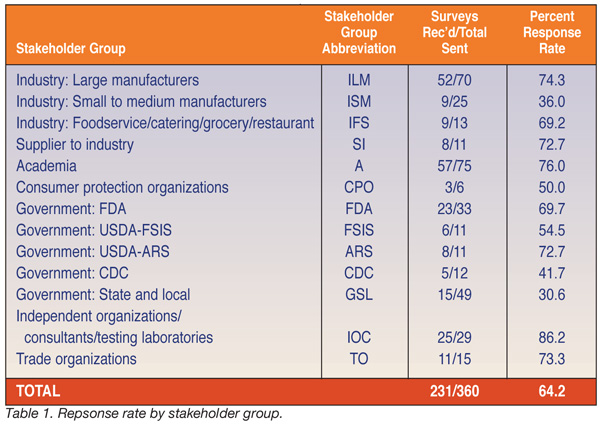
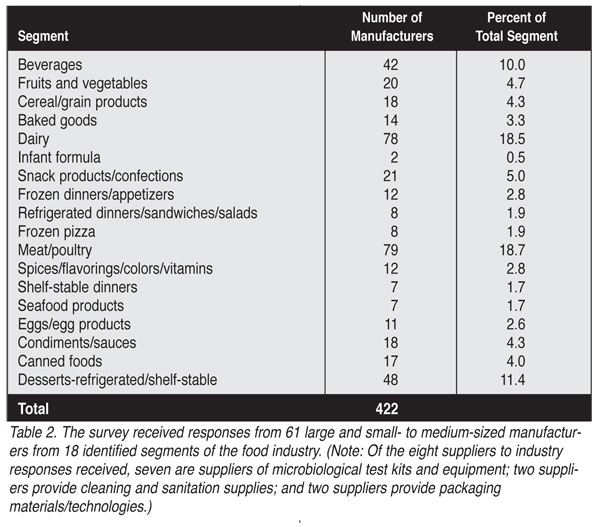
Table 3 shows the numerical microbiological food safety issue weighted priority rankings summarized by each stakeholder group (1 = highest ranking, 10 = lowest ranking). Table 4 shows these numerical rankings split into frequency top-five and frequency bottom-five rankings across stakeholder groups. Similarly, Table 5 shows the numerical rankings split into frequency top-three, frequency middle-three, and frequency bottom-four rankings across stakeholder groups.
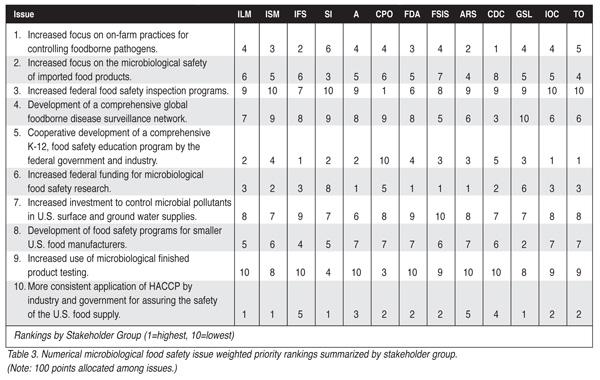
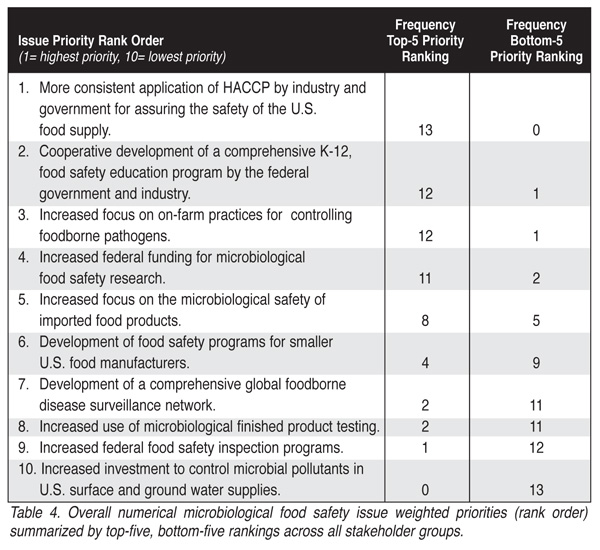
As shown in Table 4, there are some clear distinctions based on frequency top-five and frequency bottom-five rankings. More consistent application of the Hazard Analysis & Critical Control Points (HACCP) protocol by industry and government for assuring the safety of the U.S. food supply is uniformly ranked as a priority issue. The cooperative development of a comprehensive kindergarten to twelfth grade (K-12) food safety education program by the federal government and industry and increased focus on on- farm practices for controlling foodborne pathogens are the next highest ranked priority issues (12 top-five rankings each). Increased federal finding for food safety research is the next highest ranked issue with 11 top-five issues. The fifth highest issue ranking is increased focus on the microbiological safety of imported food products with eight top-five rankings. All other issues received more bottom-five rankings than top-five rankings. Increased investment to control microbial pollutants in U.S. surface and ground water supplies received no top-five priority rankings and increased federal food safety inspection programs received only one top-five ranking.
Inspection of Table 5 shows that the priority rank orders for the 10 issues does not substantially change based on frequency top-three, frequency middle- three and frequency bottom-four rankings. More consistent application of HACCP by industry and government and increased federal finding for microbiological food safety research are tied for top priority with 10 top-three rankings each. The cooperative development of a comprehensive K-12 food safety education program is the next highest priority issue with nine top-three rankings. Increased focus on on-farm pathogen control is the fourth highest priority issue with five top-three rankings and eight middle-three rankings. By virtue of 10 middle-three rankings and one top-three ranking, increased focus on the microbiological safety of imported foods is the fifth highest priority issue.
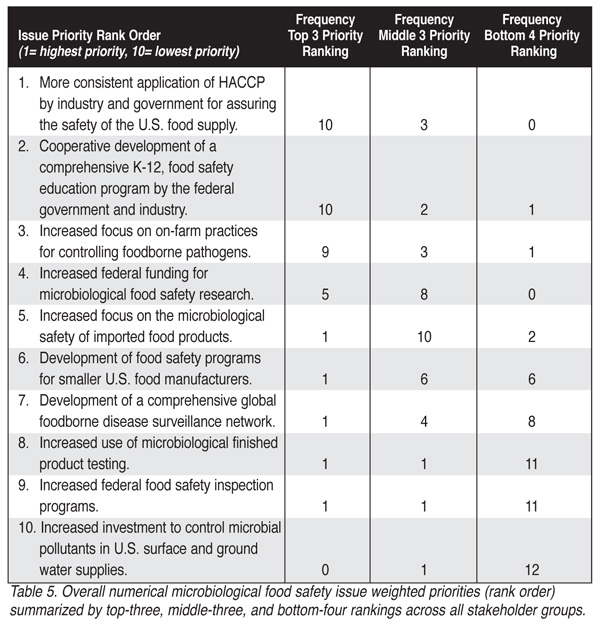
Increased investment to control microbial pollutants in U.S. surface and groundwater supplies is still the lowest priority issue with 12 bottom-four rankings and zero top-three rankings. Increased federal food safety inspection programs and increased use of microbiological finished product testing are the next lowest ranked priority issues with 11 bottom-four rankings each and only one top-three priority ranking each.
Table 3 shows some overall striking differences in weighted priority rankings among stakeholder groups. For example, consumer protection organization respondents list increased federal food safety inspection programs as their number one priority. No other stakeholder group has this issue higher than sixth on their priority list. Conversely, consumer protection group respondents are the only stakeholder group to rank the development of a comprehensive K-12 food safety education program as their lowest priority. All other stakeholder groups rank this issue in their top-five rankings and nine of 13 groups rank this issue in their top-three rankings. Similarly, consumer protection organization respondents and supplier to industry respondents rate increased use of microbiological finished product testing in their top-five rankings, while all other stakeholder groups give this issue low priority.
The CDC respondents and the U.S. Department of Agriculture’s Food Safety Inspection Service (USDA-FSIS) respondents are the only stakeholder groups to rank the development of a comprehensive global foodborne disease surveillance network in their top-five weighted priority rankings. All other respondents give lower relative priority to this issue. The issue of developing food safety programs for smaller companies appears to be a “second tier” priority item with one top-three priority ranking and six middle- three priority rankings.
Overall Conclusions
Based on both top-five and top-three weighted priority rankings across stake- holder groups, there appears to be strong support for the following issues as priority areas of focus:
• More consistent application of the HACCP system by industry and government for assuring the safety of the U.S. food supply.
• Cooperative development of a comprehensive K-12 food safety education program by the federal government and industry.
• Increased focus on on-farm practices for controlling pathogens.
• Increased federal finding for microbiological food safety research.
• Increased focus on the microbiological safety of imported food products.
There also is support for the following issue as a “second tier” priority issue based on four of 13 stakeholder groups ranking it in their top-five priorities and seven of 13 stakeholder groups ranking it in their top-six priorities:
• Development of food safety programs for smaller U.S. food manufacturers.
There is little support across stakeholder groups for the following issues:
• Increased investment to control microbial pollutants in U.S. surface and groundwater supplies.
• Increased federal food safety inspection programs.
• Increased use of microbiological finished product testing.
• Development of a comprehensive global foodborne disease surveillance network.
It appears that, if sustained focus and attention are given to the top five issues listed above, substantial progress could be made in advancing the microbiological safety of the U.S. food supply. Continued dialogue is needed to understand the major differences among stakeholder groups on specific priority issues. For example, consumer protection organizations do not support increased consumer education as a priority area, while they are the only group that strongly support increased federal food safety inspection programs as a priority area. Also, more discussion is warranted on the polarizing issue of increased use of microbiological finished product testing as a means of assuring safety. Finally, more dialogue is needed to understand why most stakeholders do not rank the issues of increased investment to control microbial pollutants in U.S. surface and groundwater supplies and the development of a comprehensive global food- borne disease surveillance network as higher priorities. Both of these areas have been the subject of much attention in the scientific and popular literature.
The World Health Assembly, which is the supreme governing body of the World Health Organization (WHO), unanimously adopted a landmark food safety resolution in May 2000.[9] This resolution expresses deep concern that foodborne illnesses associated with microbial pathogens, biotoxins and chemical contaminants in food represent a serious threat to the health of millions of people around the globe. It urged, inter alia, the integration of food safety into essential public health functions and that member states “…provide adequate resources to establish and strengthen their food safety programmes…” This historic resolution recognizes the global nature of food safety issues and calls upon “…all stake-holder—especially the private sector—to take their responsibility for the quality and safety of food production, including environmental protection awareness throughout the chain seriously…” Thorough discussion by stakeholders and timely action against the information covered in this expert survey instrument will help to achieve the goals articulated in this historic World Health Assembly resolution.
Paul A. Hall, Ph.D., is Director of Microbiology and Food Safety with Kraft Foods-North America. He joined Kraft Foods Technology Center in Glenview, IL, in 1989 as Section Manager, Chilled Foods Stability and Methods Development in the Microbiology and Food Safety Department. In 1991, he was promoted to the position of Associate Director of Microbiology and Food Safety responsible for directing research and development activities related to the microbiological safety of a wide array of Kraft Foods products and processes. In 1994, he assumed his current position with responsibility for microbiology research activities at the Glenview, IL, Tarrytown, NY and Oscar Mayer-Madison, WI locations.
Hall, a member of the Food Safety Magazine Editorial Board, is president-elect of the International Association of Food Protection; chair of the University of Georgia’s Center for Food Safety and Quality Enhancement Board of Advisors; past chairman of the National Food Processors Association’s Microbiology and Food Safety Committee; and past chair of the International Life Sciences Institute’s Microbiology and Food Safety Committee.
Acknowledgment
The author would like to acknowledge LaSalle University, Kraft Foods North America, and the survey participants for their support. A complete copy of this dissertation work can be obtained at www.dissertation.com (ISBN #1-588112- 1 58-X).
References
1. Mead, RS., et al. Food-related illness and death in the United States. Emerg. Infect. Dis., 5(5) :607-625. 1999.
2. U.S. CDC. Preliminary foodnet data on the incidence of foodborne illnesses-selected sites, United States, 1999. Morbidity and Mortality Weekly Report, 47(51):201-205. 1999.
3. U.S. CDC. Multistate outbreak of Escherichia coli 01 57:H7 infections associated with eating ground beef—U.S. Morbidity and Mortality Weekly Rpt., 51(29) :637-639. June/July 2002.
4. U.S. CDC. Update: Multistate outbreak of listeriosis—U.S., 1998—1999. Morbidity and Mortality Weekly Rpt., 47(51):1117-1118. 1999. 5. U.S. CDC. Hepatitis A associated with consumption of frozen strawberries—Michigan, March, 1997. Morbidity and Mortality Weekly Report, 46(13): 288, 295. 1997.
6. Doores, S. Food Safety: Current Status and Future Needs—A Report from the American Academy of Microbiology American Academy of Microbiology. Washington. DC. 1999.
7. U.S. DHHS Interagency Task Force on Antimicrobial Resistance. A public health action plan to combat antimicrobial resistance, Part 1:
domestic issues. www.cdc.gov/drugresistance. Jan. 18, 2001.
8. Jarvis, B. Food microbiology into the twenty- first century—a Delphi forecast. In: Food Microbiology: Advances and Prospects. T.A. Roberts and F.A. Skinner, editors. London: Academic Press. 1983.
9. World Health Organization. Fifty-third World Health Assembly. Agenda item 12.3, Food Safety, WHA 53.15. Geneva. May 20, 2000.
Looking for quick answers on food safety topics?
Try Ask FSM, our new smart AI search tool.
Ask FSM →



.webp?height=200&t=1691503719&width=200)




